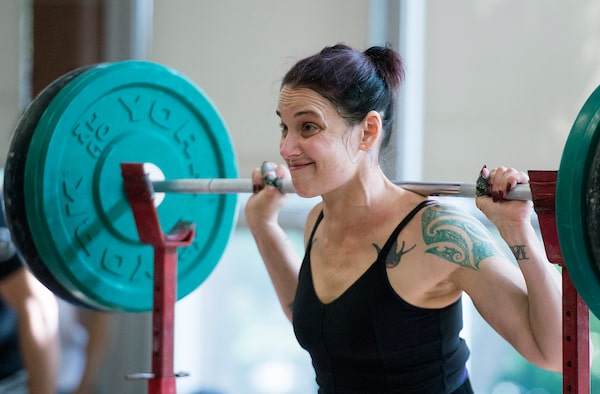
Lifting weights isn’t easy, at least not when it’s done right.Graham Hughes/The Canadian Press
It should be self-evident that the entire point of weight training is to present your body with a surmountable physical challenge. But in life, what’s obvious is often ignored in favour of what’s easy. And lifting weights isn’t easy, at least not when it’s done right. When your training is dialled-in, when you’re owning every rep of every set with weight that’s heavy relative to your ability, that’s what doing it right looks like.
How well does the scenario above describe your own typical training session? Unless you’re fortunate enough to work with skilled trainers or training partners, I’m going to guess it’s not very accurate at all, and the reason is simple: You’re choosing the wrong weights. I see it every day, lifters of all stripes either going too heavy because they think they’re indestructible or going too light because they think they’ll get hurt. Neither mindset is productive. There is a method I use for figuring out what weights to use and when to use them, but first we need to back up and establish a few things.
The weight part of weight training is often referred to as resistance or intensity (as in “resistance training” or “high-intensity training”), in part because traditional weights aren’t needed to get in shape. Whether you’re squatting a barbell, pulling on a resistance band or pressing your own body, the act itself has to be hard or else your body will never adapt and you will never get stronger.
It’s also important to understand the inverse relationship between reps and resistance. Lifting heavy (and when I say heavy, I always mean “heavy for you”) is essential because that’s what builds strength, but how long can someone maintain ideal technique when exerting near-maximal effort? To safeguard against injury without sacrificing progress, when moving heavy weights, it’s best to work in the four- to eight-rep range.
On the other end of the spectrum we have high reps with moderate weight. This approach presents its own set of challenges and is ideal for building muscle mass and enhancing mobility. Depending on the nature of the exercise and your specific goals, you’ll be focusing on anywhere from 10 to 15 reps.
Now, on to the business of choosing the right weights for the job. Any legitimate training program will offer a range of around two to four reps a set for most exercises. This is so you have room to make steady and consistent progress throughout the entirety of your program, which could last anywhere from two months to a year.
Let’s say it’s upper-body day and your program calls for incline dumbbell presses, three sets of 10 to 12 reps. For your first set you’re going to be aiming for the bottom end of that rep range. Choose a weight you’re certain you can handle – by the time you hit the halfway point you should have a clear idea whether or not this weight will work. If by rep five you’re grinding so hard your eyeballs feel as though they’re about to burst, the weight’s too heavy and it’s unlikely you’ll finish the set. If you get to rep five and you’re thinking about anything and everything aside from the weights in your hands, you need to increase the intensity.
In either case, finish the set and consider it a warm up. Start the process over again, this time with a suitably heavier pair of dumbbells. You know you’ve hit the sweet spot when you finish rep 10 feeling challenged without having compromised your form. That’s set one (or maybe it’s still your warm up, that’s your call). Rest and repeat until all sets are complete.
The next time you hit that exercise, use that same weight and keep using it until you can easily hit the top end of the rep range (this is why you should be tracking your workouts in a training journal). Once that happens, you’re ready to move up five or 10 pounds. Remember, small increments lead to big gains over time, and longevity is the name of the game.
Paul Landini is a personal trainer and health educator in Toronto.
Live your best. We have a daily Life & Arts newsletter, providing you with our latest stories on health, travel, food and culture. Sign up today.